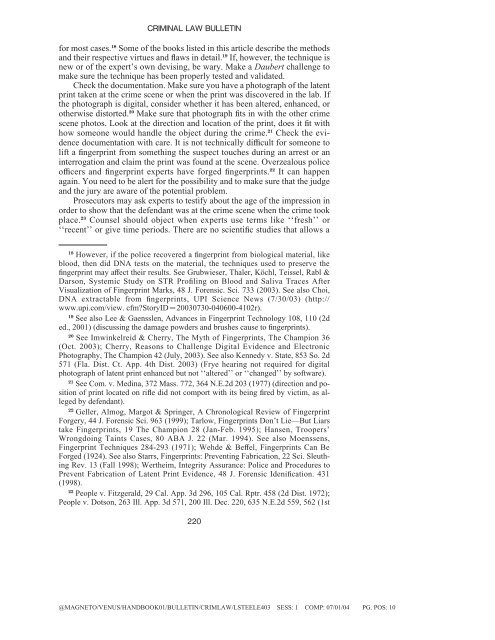Defense Challenge to Fingerprints - CLPEX.com
Defense Challenge to Fingerprints - CLPEX.com
Defense Challenge to Fingerprints - CLPEX.com
Create successful ePaper yourself
Turn your PDF publications into a flip-book with our unique Google optimized e-Paper software.
CRIMINAL LAW BULLETIN<br />
for most cases. 18 Some of the books listed in this article describe the methods<br />
and their respective virtues and �aws in detail. 19 If, however, the technique is<br />
new or of the expert’s own devising, be wary. Make a Daubert challenge <strong>to</strong><br />
make sure the technique has been properly tested and validated.<br />
Check the documentation. Make sure you have a pho<strong>to</strong>graph of the latent<br />
print taken at the crime scene or when the print was discovered in the lab. If<br />
the pho<strong>to</strong>graph is digital, consider whether it has been altered, enhanced, or<br />
otherwise dis<strong>to</strong>rted. 20 Make sure that pho<strong>to</strong>graph �ts in with the other crime<br />
scene pho<strong>to</strong>s. Look at the direction and location of the print, does it �t with<br />
how someone would handle the object during the crime. 21 Check the evidence<br />
documentation with care. It is not technically di�cult for someone <strong>to</strong><br />
lift a �ngerprint from something the suspect <strong>to</strong>uches during an arrest or an<br />
interrogation and claim the print was found at the scene. Overzealous police<br />
o�cers and �ngerprint experts have forged �ngerprints. 22 It can happen<br />
again. You need <strong>to</strong> be alert for the possibility and <strong>to</strong> make sure that the judge<br />
and the jury are aware of the potential problem.<br />
Prosecu<strong>to</strong>rs may ask experts <strong>to</strong> testify about the age of the impression in<br />
order <strong>to</strong> show that the defendant was at the crime scene when the crime <strong>to</strong>ok<br />
place. 23 Counsel should object when experts use terms like ‘‘fresh’’ or<br />
‘‘recent’’ or give time periods. There are no scienti�c studies that allows a<br />
18 However, if the police recovered a �ngerprint from biological material, like<br />
blood, then did DNA tests on the material, the techniques used <strong>to</strong> preserve the<br />
�ngerprint may a�ect their results. See Grubwieser, Thaler, Köchl, Teissel, Rabl &<br />
Darson, Systemic Study on STR Pro�ling on Blood and Saliva Traces After<br />
Visualization of Fingerprint Marks, 48 J. Forensic. Sci. 733 (2003). See also Choi,<br />
DNA extractable from �ngerprints, UPI Science News (7/30/03) (http://<br />
www.upi.<strong>com</strong>/view. cfm?S<strong>to</strong>ryID}20030730-040600-4102r).<br />
19 See also Lee & Gaensslen, Advances in Fingerprint Technology 108, 110 (2d<br />
ed., 2001) (discussing the damage powders and brushes cause <strong>to</strong> �ngerprints).<br />
20 See Imwinkelreid & Cherry, The Myth of <strong>Fingerprints</strong>, The Champion 36<br />
(Oct. 2003); Cherry, Reasons <strong>to</strong> <strong>Challenge</strong> Digital Evidence and Electronic<br />
Pho<strong>to</strong>graphy, The Champion 42 (July, 2003). See also Kennedy v. State, 853 So. 2d<br />
571 (Fla. Dist. Ct. App. 4th Dist. 2003) (Frye hearing not required for digital<br />
pho<strong>to</strong>graph of latent print enhanced but not ‘‘altered’’ or ‘‘changed’’ by software).<br />
21 See Com. v. Medina, 372 Mass. 772, 364 N.E.2d 203 (1977) (direction and position<br />
of print located on ri�e did not <strong>com</strong>port with its being �red by victim, as alleged<br />
by defendant).<br />
22 Geller, Almog, Margot & Springer, A Chronological Review of Fingerprint<br />
Forgery, 44 J. Forensic Sci. 963 (1999); Tarlow, <strong>Fingerprints</strong> Don’t Lie—But Liars<br />
take <strong>Fingerprints</strong>, 19 The Champion 28 (Jan-Feb. 1995); Hansen, Troopers’<br />
Wrongdoing Taints Cases, 80 ABA J. 22 (Mar. 1994). See also Moenssens,<br />
Fingerprint Techniques 284-293 (1971); Wehde & Be�el, <strong>Fingerprints</strong> Can Be<br />
Forged (1924). See also Starrs, <strong>Fingerprints</strong>: Preventing Fabrication, 22 Sci. Sleuthing<br />
Rev. 13 (Fall 1998); Wertheim, Integrity Assurance: Police and Procedures <strong>to</strong><br />
Prevent Fabrication of Latent Print Evidence, 48 J. Forensic Ideni�cation. 431<br />
(1998).<br />
23 People v. Fitzgerald, 29 Cal. App. 3d 296, 105 Cal. Rptr. 458 (2d Dist. 1972);<br />
People v. Dotson, 263 Ill. App. 3d 571, 200 Ill. Dec. 220, 635 N.E.2d 559, 562 (1st<br />
220<br />
@MAGNETO/VENUS/HANDBOOK01/BULLETIN/CRIMLAW/LSTEELE403 SESS: 1 COMP: 07/01/04 PG. POS: 10



